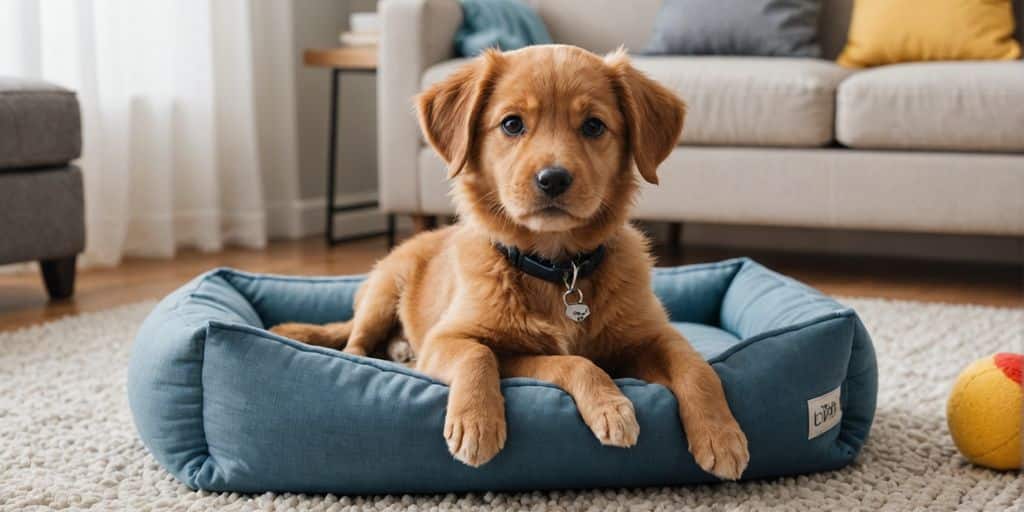Bringing a new puppy home is an exciting experience, but housebreaking can be a daunting task for new dog owners. With patience, consistency, and the right techniques, you can make the process smoother for both you and your furry friend. This guide provides essential tips to help you successfully housebreak your puppy, creating a happier and cleaner home environment.
Key Takeaways
- Consistency is key to successful puppy housebreaking.
- Positive reinforcement, like treats and praise, encourages good behavior.
- Crate training can be a helpful tool in teaching your puppy to hold their bladder.
- Accidents will happen; handle them calmly and avoid punishment.
- Understanding your puppy’s signals can prevent accidents and speed up the housebreaking process.
Understanding the Basics of Puppy Housebreaking
Housebreaking your puppy is one of the first big challenges you'll face as a new dog owner. It's all about teaching your puppy where and when it's appropriate to go potty. Let's break down the basics to get you started on the right foot.
Why Housebreaking is Important
Housebreaking is crucial for maintaining a clean and healthy home environment. A well-housebroken puppy is less likely to damage furniture and other household items. It also helps in building a stronger bond between you and your puppy as you both learn to communicate and understand each other's needs.
Common Challenges New Dog Owners Face
New dog owners often face several challenges when housebreaking their puppies. These can include frequent accidents, difficulty in establishing a routine, and understanding your puppy's signals. Puppies have small bladders and high metabolisms, so they need to go to the bathroom more frequently than adult dogs. This can be especially challenging if you're not home to let them out regularly.
Setting Realistic Expectations
It's important to set realistic expectations when housebreaking your puppy. Accidents are part of the process, and patience is key. Remember, every puppy learns at their own pace. Celebrate small victories and be patient with your furry friend. Training is not just about teaching commands; it's about building a trusting and loving relationship.
Housebreaking is a journey that requires consistency, patience, and a lot of positive reinforcement. By focusing on these aspects, you can create a clean environment and foster a successful housebreaking process, leading to a happy and well-trained companion.
Creating a Consistent Routine
Establishing a Feeding Schedule
A regular feeding schedule is crucial for housebreaking success. What goes into a puppy on a schedule comes out on a schedule. Feed your puppy at the same times each day to help them eliminate at consistent times. Puppies usually need to eat two to three times a day, depending on their age. This predictability makes it easier to anticipate when they need to go outside.
Timing Potty Breaks
Timing is everything when it comes to potty breaks. Puppies typically need to go out first thing in the morning, after meals, and after naps. A good rule of thumb is to take your puppy's age in months and divide it by two to determine how many hours they can hold it. For example, a 4-month-old puppy can usually wait about two hours between potty breaks. Let's break down some general rules and specific tips for creating a successful potty training routine for your new furry friend.
Using Commands and Cues
Using consistent commands and cues can help your puppy understand what you expect from them. Choose a simple phrase like "go potty" and use it every time you take your puppy outside. Over time, they'll associate the phrase with the action. Be patient and consistent, and soon your puppy will understand what you want them to do.
Consistency is key in housebreaking. Stick to a routine, and your puppy will learn faster and feel more secure.
By following these steps, you'll create a routine that helps your puppy learn when and where to go, making housebreaking a smoother process for both of you.
The Power of Positive Reinforcement
Rewarding Good Behavior
Positive reinforcement is a powerful tool for training your puppy. By rewarding good behavior, you encourage your puppy to repeat those actions. This method not only helps in managing unwanted behaviors but also strengthens the bond between you and your pet. Consistency is key; always reward your puppy immediately after they do something right.
Using Treats Effectively
When it comes to training, using treats is a game changer! Start by rewarding your puppy with treats when they perform a desired behavior. This helps them associate good behavior with something they love. Just remember to gradually reduce the treats as they learn, so they don’t only perform for rewards.
Praise and Encouragement
Don’t underestimate the power of your voice! Use lots of praise and encouragement when your puppy does well. A simple "good boy" or "great job" can boost their confidence and make them want to repeat the behavior. Celebrate those little victories!
Consistency in training will reinforce the behaviors you've been teaching, making them more likely to stick.
By following these tips, you’ll not only help your puppy learn better but also create a more enjoyable experience for both of you!
Crate Training: A Helpful Tool
Crate training can be a fantastic way to help housebreak your puppy. When done right, it provides a safe space for your puppy to relax and sleep, and it also helps with potty training. Dogs naturally avoid soiling their sleeping area, making the crate a useful tool in teaching them to hold their bladder until they are outside.
Choosing the Right Crate
Picking the right crate is crucial. It should be large enough for your puppy to stand up, turn around, and lie down comfortably. However, if the crate is too big, your puppy might use one end as a bathroom. Some crates come with dividers, allowing you to adjust the space as your puppy grows.
Introducing Your Puppy to the Crate
Start by making the crate a positive place. Leave the door open and place treats inside to encourage your puppy to explore. Gradually, you can close the door for short periods while you are nearby. Remember, the crate should never be used as a punishment.
"Unlock the Secrets to a Blissful, Healthier Puppy: Discover the Benefits of Holistic Housebreaking"
Using the Crate for Housebreaking
Incorporate the crate into your potty training routine. Take your puppy outside immediately after letting them out of the crate. This helps them associate going outside with potty time. Consistency is key, so stick to a schedule and be patient.
Crate training, when done correctly, can make housebreaking much easier and less stressful for both you and your puppy. Embrace the process and enjoy the journey of raising a well-behaved furry friend.
Handling Accidents Gracefully
Cleaning Up Properly
Accidents are bound to happen, so it's important to clean up properly. Use an enzymatic cleaner to remove all traces of odor. This prevents your puppy from being drawn back to the same spot. Thorough cleaning is key to avoiding repeat accidents.
Avoiding Punishment
When your puppy has an accident, stay calm. Avoid scolding or punishing them, as this can create fear and anxiety. Instead, gently guide them outside to finish their business. Remember, accidents are an inevitable part of potty training.
Learning from Mistakes
Each accident is a learning opportunity. Ask yourself if your puppy had too much freedom or if you missed their signals. Adjust your routine to prevent future accidents. Consistency and patience are essential for successful housebreaking.
Stay positive and patient. Every accident is a step towards better understanding your puppy's needs.
Socialization and Housebreaking
Why Socialization Matters
Socializing your puppy is crucial for their overall development. It helps them become comfortable in different situations and reduces anxiety. A well-socialized puppy is more likely to be well-behaved and confident. This makes housebreaking easier because a calm puppy is more likely to follow routines and commands.
Introducing Your Puppy to New Environments
Start by gradually introducing your puppy to new environments. Take them to different places like parks, pet-friendly stores, and friends' houses. Use a leash to keep them safe and controlled. This exposure helps them get used to various sights, sounds, and smells, making them less likely to be scared or anxious.
Balancing Socialization with Housebreaking
Balancing socialization with housebreaking can be tricky but is essential. Here are some tips:
- Stick to a Routine: Keep a consistent schedule for feeding, potty breaks, and socialization.
- Use Positive Reinforcement: Reward your puppy with treats and praise when they do well in new environments or follow housebreaking rules.
- Be Patient: Understand that accidents will happen. Stay calm and clean up properly without scolding your puppy.
Remember, the goal is to make your puppy feel safe and secure while learning new things. A well-socialized puppy is easier to train and more adaptable to changes in their environment.
By following these tips, you'll help your puppy become a well-adjusted and housebroken member of your family.
Advanced Tips for Housebreaking Success
Recognizing Your Puppy’s Signals
Understanding your puppy's signals is crucial for successful housebreaking. Pay attention to signs like sniffing, circling, or whining. These behaviors often indicate that your puppy needs to go outside. Recognizing these signals early can prevent accidents and reinforce good habits.
Gradually Increasing Freedom
As your puppy becomes more reliable, you can gradually increase their freedom in the house. Start by allowing access to one room at a time. Use baby gates or closed doors to limit their space. This method helps them learn to control their bladder and bowel movements in a controlled environment.
When to Seek Professional Help
If you're struggling with housebreaking despite your best efforts, it might be time to seek professional help. A dog trainer or behaviorist can provide personalized guidance and strategies. Remember, every puppy is different, and sometimes expert advice is needed to address specific challenges.
Housebreaking is a journey that requires patience and consistency. Celebrate small victories and stay optimistic. With time and effort, your puppy will learn to follow the routine and keep your home clean.
Conclusion
Housebreaking your new puppy might seem like a big task, but with patience, consistency, and the right approach, it can be a rewarding experience for both you and your furry friend. Remember, every puppy learns at their own pace, so celebrate the small victories along the way. By following these essential tips, you'll not only create a cleaner home but also build a stronger bond with your pup. Happy training, and enjoy the journey with your new best friend!
Frequently Asked Questions
How long does it take to housebreak a puppy?
Housebreaking a puppy can take a few weeks to several months, depending on the puppy's age, breed, and consistency in training. Patience and consistency are key.
What should I do if my puppy has an accident in the house?
If your puppy has an accident, clean it up immediately with an enzymatic cleaner to remove the scent. Avoid punishing your puppy, as this can create fear. Instead, focus on reinforcing good behavior.
How often should I take my puppy outside for potty breaks?
Puppies need frequent potty breaks. A good rule of thumb is to take them out every 1-2 hours, especially after eating, drinking, playing, or napping.
Is crate training helpful for housebreaking?
Yes, crate training can be very effective. Puppies naturally avoid soiling their sleeping area, so a properly sized crate can help them learn to hold their bladder.
What are some signs that my puppy needs to go potty?
Common signs include sniffing around, circling, whining, or heading towards the door. Paying attention to these signals can help prevent accidents.
Can older dogs be housebroken too?
Yes, older dogs can be housebroken using the same techniques as puppies. It may take a bit longer, but with patience and consistency, they can learn too.


